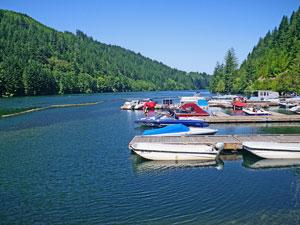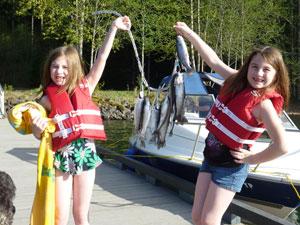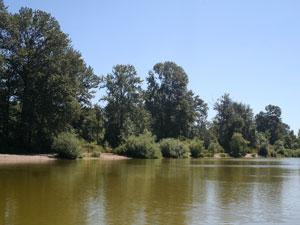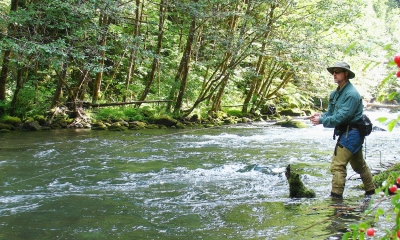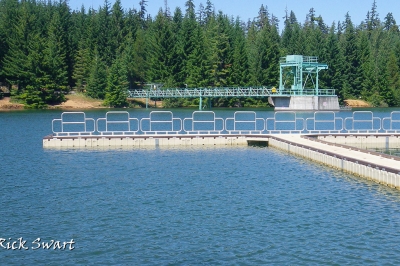
Easy angling in the Willamette Zone
Abundant rainfall feeds the massive Willamette River watershed, tamed by a system of reservoirs stocked annually with hundreds of thousands of rainbow trout. Some of these reservoirs also grow trophy-size largemouth and smallmouth bass, and lots of bluegill, brown bullhead and crappies. Salmon and steelhead navigate the Willamette and its productive tributaries, many of which are also home to rainbow and cutthroat trout.

Table of contents
Part 1: Easy Angling Oregon - An Introduction
Part 2: Easy Angling Oregon - Northwest Zone
Part 3: Easy Angling Oregon - Southwest Zone
Part 4: Easy Angling Oregon - Willamette Zone (you are here)
Part 5: Easy Angling Oregon - Central Zone
Part 6: Easy Angling Oregon - Southeast Zone
Part 7: Easy Angling Oregon - Northeast Zone
16 great places for families to fish in the Willamette Valley
Featured Waters:
- Timothy Lake
- St. Louis Ponds
- Benson Lake
- North Fork Reservoir
- Henry Hagg Lake
- Detroit River
- Foster Reservoir
- Waverly Lake
- Freeway Lakes
- Walter Wirth Lake
- Fall Creek
- Alton Baker Canoe Canal
- Clear Lake
- Leaburg Lake
- Salmon Creek
- Dexter Reservoir
Timothy Lake
A popular and diverse fishery close to Portland. The lake is set amongst a mature Douglas-fir forest and holds three kinds of trout as well as kokanee. Several U.S. Forest Service campgrounds and day use areas make is a great family destination. The lake is open all year but snow often blocks access until the spring.
What to fish for:
Stocked regularly with rainbow trout. Wild cutthroat, brown and brook trout are also in the reservoir. Only brown, brook and adipose fin-clipped rainbow trout may be kept.
Fishing tips:
All lake-fishing techniques can be effective here. Best bank fishing is along the southern shore, near the dam, and at the mouths of inlet streams where fly fishing can be especially good in late summer and fall. Kokanee are available at shallower depths from spring through early summer.
Facilities:
USFW Hoodview: campground, accessible, restrooms or toilet, picnic area, boat launch or ramp, parking, entrance or other day use fee.
USFS Oak Fork: campground, accessible, restrooms or toilet, picnic area, boat launch or ramp, parking, entrance or other day use fee.
USFS Pine Point: campground, accessible, restrooms or toilet, picnic area, boat launch or ramp, fishing pier or dock, parking, entrance or other day use fee.
Getting there:
About 11 miles east of Government Camp on Hwy 26, turn south onto Forest Rd. 42 (Skyline Rd.), then west onto Forest Rd. 57, which leads to the lake. The road may be blocked by snow until June. An unpaved route from Estacada is considerably slower.
St. Louis Ponds
This is a 240-acre public fishing complex owned by ODFW. It contains 54 developed acres of water in seven ponds, which provide habitat for trout and warmwater species. The ponds are open all year but are closed daily from one hour after sunset until one hour before sunrise. The access gate is closed during waterfowl season but anglers can walk in during this time.
In 2012, ODFW completed construction of an ADA-approved paved pathway and several fishing platforms and floating docks that make it possible for people in wheelchairs to reach many of the ponds in the complex.
What to fish for:
The seven ponds hold crappie, bluegill, largemouth bass, redear sunfish, green sunfish and channel catfish. Pond 3 is stocked with rainbow trout in the spring.
Fishing tips:
All lake fishing techniques will work here. Trout are stocked in the cooler spring months. Warmwater fishing is best from late spring through fall. Fish for bass and panfish near weed beds, submerged logs or other areas that provide cover. In the warm summer months, aquatic vegetation can make fishing more difficult.
Facilities:
The seven ponds offer 7 miles of shoreline designed for bank fishing. Boats and flotation devices are not allowed.
Restrooms or toilet, accessible, fishing pier or dock.
Getting there:
West of I-5 about 15 miles north of Salem and 2 miles west of Gervais. From Gervais, take St. Louis Rd. west; turn left onto Tesch Ln. before crossing the railroad tracks.
Benson Lake
A small lake with good bank access in the Benson State Recreation Area just off I-84 west of Multnomah Falls.
What to fish for:
Stocked with legal-size trout in June. Brown bullhead, white crappie, pumpkinseed sunfish and largemouth bass also are available.
Fishing tips:
Standard lake-fishing techniques will work here. Good bank access but also good for non-motorized rafts, boats and float tubes that don’t require a boat ramp.
Facilities:
Benson State Recreation Area: restrooms or toilet, picnic area, fishing pier or dock, accessible.
Getting there:
From Portland, take I-84 east to exit 30. Benson Lake will be on the left. There is no exit to Benson Lake for westbound traffic. So, from Hood River, take I-84 west past Benson Lake to exit 22. Take a left at the top of the exit, then a second left to return on I-84 eastbound. Take exit 30 to Benson Lake.
North Fork Reservoir
This reservoir on the Clackamas River outside of Estacada offers a scenic environment surrounded by the cooling shade of mature forests. With plenty of stocked trout and easy access from Portland, this is a great family fishing destination.
What to fish for:
Stocked regularly with rainbow trout. Wild cutthroat, brown and brook trout are also in the reservoir but these fish are catch-and-release only. Only adipose fin-clipped trout may be kept.
Fishing tips:
Standard lake-fishing techniques will work here. The upper end of the reservoir where trout are stocked offers the best fishing. There are many bank fishing locations and an area near the mouth is great for kids. If using a boat, troll with spinner combinations.
Small Fry Lake, a one-acre lake within the Promontory Park, was developed for the exclusive use of young anglers.
Facilities:
Promontory Park (Portland General Electric)—open mid-May through mid-September. Campground, restrooms or toilet, boat launch or ramp, boat rentals, accessible.
Getting there:
The reservoir is located 7 miles south of Estacada off Hwy 224.
Henry Hagg Lake
Nestled in the foothills of the Coast Range, Hagg Lake is far enough from the city to feel like the country, but close enough to Portland for a great day of fishing and getting home in time for dinner. The lake is located in Scoggins Valley Park and is maintained and operated by Washington County. The park features numerous picnic areas, two boat launching facilities, ADA fishing pier, more than 15 miles of hiking trails, and observation decks for wildlife and bird watching.
The park is open year around. Parking fee.
What to fish for:
The lake is heavily stocked with legal-sized rainbow trout. Smallmouth bass, yellow perch, bluegills, crappies and bullheads also are well established. Largemouth bass and cutthroat trout also are present. Holdover hatchery rainbow trout can reach 6 pounds and smallmouth bass reach trophy size due to the abundant fish forage.
Fishing tips:
All lake-fishing techniques can work here. In spring, fish for bass with lures imitating perch, crayfish and minnows. Plastic worms, grubs and jigs can be productive all year. Bank anglers are successful early in the season using spinners and bait near boat ramps. Smallmouth bass move into the lake’s shallow arms when water temperatures are 60 to 65 degrees.
Fishing for stocked trout is best in spring and fall when the shallows are cool. Tanner Creek Arm and the cove north of Eagle Point Recreation Area (east shore) are reliable for yellow perch and look for bluegills and bullheads in the coves. There are two boat ramps – on the east and west shores. Best bank access is from the dam.
Facilities:
Scoggins Valley Park: restrooms or toilet, accessible, picnic area, boat launch or ramp, fishing pier or dock.
Getting there:
From Hwy 47 south of Dilley near Forest Grove, follow Scoggins Valley Rd. about 3 miles to the lake.
Detroit Lake
A large, scenic reservoir 50 miles east of Salem, this lake is very popular for fishing, boating, water skiing and other water sports.
What to fish for:
ODFW releases 125,000 legal-sized rainbow trout between April and October, along with fingerling rainbow, kokanee and Chinook.
Fishing tips:
Standard lake fishing techniques will work here. Fishing for rainbow trout is most successful in the spring, early summer and fall when surface temperatures are cooler. By mid-summer, trout releases are mostly in the North Santiam Arm where cold water is entering the reservoir.
By late July or August most of the kokanee may be 80-100 feet deep; downriggers are a advantage, but a heavier fishing pole with sufficient weight will work. Common techniques include jigging with buzz bombs or kokanee jigs— pink or red are effective—and trolling using a Ford Fender or other flasher with a spinner behind it and some white corn or piece of worm on the hooks.
Anglers fishing off the dam in the spring do quite well fishing for salmon as they leave the reservoir.
Facilities:
Several US Forest Service campgrounds – Cove Creek, Hoover, Santiam Flats.
Boat rentals and other amenities are available at Kane’s Marina and the Detroit Lake Resort.
Detroit Lake State Recreation Area: campground, accessible, restrooms or toilet, picnic area, boat launch or ramp, parking, entrance or other day use fee.
Mongold Day Use Area: restrooms or toilet, picnic area, boat launch or ramp.
USFS Upper Arm: restrooms or toilet, picnic area, fishing pier or dock, parking, entrance or other day use fee.
USFS Detroit Flats: restrooms or toilet, picnic area, boat launch or ramp.
Getting there:
Adjacent to Hwy 22, about 50 miles east of Salem.
Foster Reservoir
This scenic, 1,200 acre reservoir on the South and Middle forks of the Santiam River is nestled in the Cascade foothills just east of Sweet Home. Good fishing and camping facilities make it a popular family destination.
What to fish for:
Heavily stocked with rainbow trout from April to June. A small lake at Sunnyside Park has stocked trout, bass, bullhead and bluegill, and is a good place for youngsters.
Fishing tips:
Bank fishing is good using standard lake-fishing techniques. Bank fishing is popular near the dam at the Army Corps of Engineers (ACOE) park and at flat areas along the south side of the reservoir. The north shore or Middle Fork Arm also offer good bank fishing with fewer crowds. Boat fishing is best April 1 to mid-June and trolling spinners is a popular choice. There are four boat ramps on the reservoir.
Facilities:
Sunnyside County (Linn) Park: campground, restrooms or toilet, picnic area, boat launch or ramp.
Gedney Creek County (Linn) Boat Ramp: restrooms or toilet, boat launch or ramp.
Calkins County (Linn) Boat Ramp: restrooms or toilet, boat launch or ramp.
Lewis County (Linn) Park: restrooms or toilet, boat launch or ramp, picnic area, parking, entrance or other day use fee.
Getting there:
Foster Reservoir is located 3 miles east of Sweet Home on Hwy 20. Take the Hwy 34 (Corvallis) exit off I-5 and head east about 20 miles toward Lebanon and Sweet Home.
Nearby Green Peter Reservoir (just four miles northeast of Foster on Quartzville Rd) is best-known for its kokanee fishery, though stocked rainbow trout and largemouth bass are also available. Anglers can find bank access via the network of logging and Forest Service roads around the lake – start at Thistle Creek and Whitcomb Creek parks or along Quartzville Dr. There also are two boat ramps on the north shore.
Waverly Lake
A pretty little urban pond in Albany’s Waverly Park.
What to fish for:
Stocked with trout in April and May. Excellent warmwater fishing, including some good-sized largemouth bass, later in the season.
Fishing tips:
Standard lake-fishing techniques will work here. Excellent bank fishing opportunities, including a fishing dock accessible to disabled anglers. Also suitable for a pontoon boat, float tube, canoe or other small water craft. Paddle boats are available for rent during summer months.
Facilities:
Waverly Park: restrooms or toilet, picnic area, boat launch or ramp, fishing pier or dock, accessible.
Getting there:
Waverly Lake is located in Albany on 99E just west of I-5.
Freeway Lakes
A series of three ponds on either side of I-5 just south of Albany in Freeway Lakes County Park.
What to fish for:
Stocked with rainbow trout in April and May. Later in the season target largemouth bass, crappie and bluegill.
Fishing tips:
Standard lake fishing techniques will work here. Use grubs and jigs for crappies. Fish for bass along the lake shore near fallen trees and snags. Bank fishing opportunities are good for the two lakes to the east of I-5. There is a boat ramp to launch small boats on the largest lake on the west side of I-5.
Facilities:
Freeway Lakes County (Linn) Park: restrooms or toilet, picnic area.
Getting there:
Take the Hwy 34 (Corvallis) exit off I-5 and go a short distance east to Seven Mile Ln. Go north on Seven Mile then right on to Three Lakes Rd. From Albany, take the Hwy 20 (Lebanon) exit and go east to Spicer Rd. (Home Depot). Follow Spicer Rd. a short distance then travel south on Three Lakes Rd.
Walter Wirth Lake
A great family fishing destination within the Cascade Gateway Park near the Salem airport. Open year round.
What to fish for:
Stocked with trout from April through June. Several warmwater species also area available.
Fishing tips:
Standard lake-fishing techniques will work here. Excellent bank fishing opportunities with some access for handicapped anglers. Small boat slide will accommodate non-motorized boats, rafts, canoes and kayaks.
Facilities:
Cascade Gateway Park: restrooms or toilet, picnic area. fishing pier or dock, accessibility
Getting there:
From Hwy 22 just west of I-5, turn south onto Turner Rd. SE.
Fall Creek (above Fall Creek Reservoir)
A beautiful stream flowing 30 miles from the Cascades into Fall Creek Reservoir. The 13-mile stretch just above the reservoir is regularly stocked with trout from late April to mid-June. Good access from Willamette National Forest road.
What to fish for:
Stocked with legal-size hatchery rainbow trout. Native cutthroat and rainbow trout are also present.
Fishing tips:
Standard stream-fishing techniques will work here. Bait and spinners are most effective early in the season, while fly fishing gets better in summer through fall. Fish near hatchery trout release points (near campgrounds) and where fish hold near tributary junctions and bedrock pools. The best fishing for native cutthroat and rainbow tends to be away from hatchery release locations.
Facilities:
There are several US Forest Service campgrounds along Fall Creek, including Bed Rock, Puma Creek, Dolly Varden, Big Pool and Broken Bowl. Bedrock Campground hosts a popular swimming hole.
Getting there:
From I-5 south of Springfield, take Hwy 58 east to Dexter Reservoir. Cross Dexter Reservoir on the Lowell Rd. and continue north to Unity County Rd. 6204 (becomes Forest Rd. 18) to Fall Creek Reservoir. Forest Rd. 18 follows Fall Creek to its headwaters. Ten-mile long Fall Creek National Recreation Trail begins at Dolly Varden Campground and has many access points.
Alton Baker Canoe Canal
The Alton Baker Canoe Canal in Eugene-Springfield is a 2-mile long water diversion constructed along an old river meander off of the Willamette River. The waterway was created in 1974 for recreational boating and today provides good in-town fishing opportunities for stocked trout.
This is an excellent area to introduce young anglers to fishing because of the number of fish released, the large unobstructed casting area and the very easy and safe access along the canal.
What to fish for:
Stocked with legal-sized rainbow trout at several locations along the length of the canal from February through mid-November. The canal also is open for trout and adipose fin-clipped steelhead all year.
Fishing tips:
Standard trout-fishing methods will work here.
Facilities:
Alton Baker Park (City of Eugene): restrooms or toilet, picnic area.
Getting there:
The Alton Baker Canoe Canal begins just east of I-5 in Springfield, runs under the interstate and through Alton Baker Park before reentering the Willamette River near the Ferry Street Bridge. In Springfield, the canal is accessed from Eastgate Woodlands Park. In Eugene, the canal is accessed from Leo Harris Parkway, and at the west end near the Day Island Rd. parking lot (off of Club Rd.).
Clear Lake
Crystal clear Clear Lake is the source of the McKenzie River high in the Willamette National Forest. Regularly stocked with trout it also has good camping and hiking opportunities, as well as a resort with boats for rent. Open for fishing year-round.
Clear Lake was formed when a lava flow blocked the McKenzie River , which flooded and inundated a mature Douglas-fir forest. The lake’s cold waters have preserved the standing trees, which are sometimes called the Underwater Forest.
What to fish for:
Heavily stocked with rainbow trout from late April through August. Brook trout also are available.
Fishing tips:
Standard lake-fishing techniques will work here. Hiking trails lead to several bank fishing locations around the lake, but the lake may be best fished by boat.
Facilities:
Clear Lake Resort and County (Linn) Park: campground, restrooms or toilet, boat launch or ramp, boat rentals.
Getting there:
Located on Hwy 126 just south of the junction with Hwy 20.
Leaburg Lake
This small, 40-acre lake was created when Leaburg Dam was built on the McKenzie River. Stocked trout, easy access and good boat and bank access.
What to fish for:
Regularly stocked with rainbow trout from late April to mid-August.
Fishing tips:
Standard lake-fishing techniques will work here. Use of bait allowed. Only adipose fin-clipped trout may be harvested to protect native trout.
Facilities:
No facilities
Getting there:
From I-5 take exit 194A near Eugene and head east on I-105. Turn onto Hwy 126 and continue east. Leaburg Lake is between mile posts 24 and 25 and is visible from the highway.
Salmon Creek
This stream is just east of Oakridge and has great public access to areas that are regularly stocked.
What to fish for:
Regularly stocked with rainbow trout from the fourth Saturday in April through mid-August. Wild trout also are available.
Fishing tips:
Standard river-fishing techniques will work here. Wading could be a challenge for the very young, or those with uncertain footing. Good access from Forest Rd. 24.
Facilities:
USFS Salmon Creek Falls Campground and Day Use Area: campground, restrooms or toilet, picnic area.
Getting there:
Follow Hwy 58 east to Oakridge. Turn left at the signal to downtown. From downtown follow Salmon Creek Rd. (Forest Rd. 24).
Dexter Reservoir
A fair-size reservoir near Eugene on the Middle Fork Willamette River. Good access for both bank and boat fishing. Open to fishing year-round.
What to fish for:
Stocked with rainbow trout late February through late April, and again in the fall.
Fishing tips:
Standard lake-fishing techniques will work here. Good bank fishing from the picnic area on the causeway near the covered bridge.
Facilities:
Dexter State Recreation Site: restrooms or toilet, picnic area, boat launch or ramp.
Lowell State Recreation Site: restrooms or toilet, picnic area, boat launch or ramp.
USACE Orchard Park: restrooms or toilet, picnic area.
Getting there:
From I-5 travel east on Hwy 58. The Reservoir is visible on the north side of the highway near Lowell.
Header photo by Rick Swart




